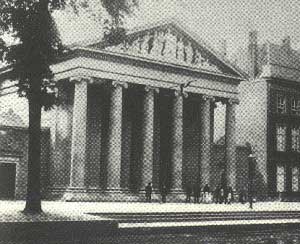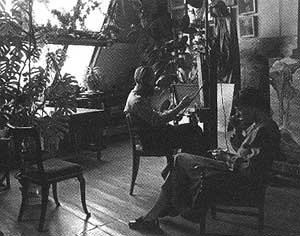|
|

THE ROYAL ACADEMY OF ARTS
IN THE HAGUE
|
In a Nazi propaganda pamphlet denouncing ‘Ontaarde Kunst’ (Improper Art), Johfra came across the Surrealist works of Dali, Ernst, Tanguy, and Magritte. Particularly Dali’s works struck a chord with him, and this modern master was added to his more classical pantheon. He began painting surrealist works with a classical technique in 1941.
Since his studies (1934 - 1942) co-incided with the Second World War and the German occupation of Holland, the teenager suffered all this time through food and fuel rationing, hunger, and even Allied bombings. In 1945, an Allied bomb destroyed all the works he’d accomplished up to that time - some 400 paintings and 1000 drawings.
Rather than feeling depressed and defeated, this tragic event inspired him to begin anew. He produced allegorical self-portaits and dream-like landscapes with slender organic forms, their torn draperies moved by invisible winds. He also produced Surrealist works in classical technique at a time when figurative art was pronounced ‘dead’ and Surrealism deemed ‘outmoded’ and ‘kitsch’ His first exhibition in 1943, under the name Johfra, received negative critiques.
|
|
|
|
|
PARIS - SPRING 2003
THE HAGUE PERIOD
1945 - 1962
|
In 1945, Johfra acquired a studio on Willemstraat in the Hague. A different genre of works emerged at this time: classical nudes on mythological subjects - Andromeda or Queen of the Night. Anatomically perfect, an intense eroticism also emanates from these figures. Though Johfra kept a diary from his early youth, in 1945 he began writing these in code - a habit he would keep up intermittantly for the next five years.
One year later, in 1946, he met the painter Angèle Thérèse Blomjous, whom he knew initially as Diavola. He considered her to be dangerous. In his Journal, he confided “when I saw her, I was seized by an inexplicable panic and an urge to escape.”
|

JOHFRA AND DIANA
|
Still, through a series of April Fool circumstances, the two of them became intimate. He called her, at various times, Angel, Anushka, and Diana. They soon became engaged and, in 1952, they married. Keeping one of those nicknames and adopting his surname, Angèle Thérèse Blomjous eventually became Diana Vandenberg.
|
|
|
|

